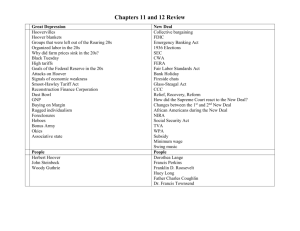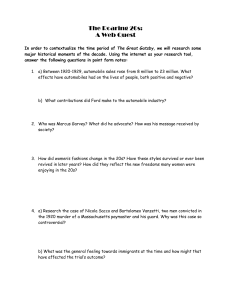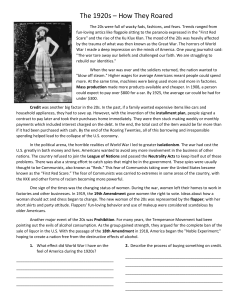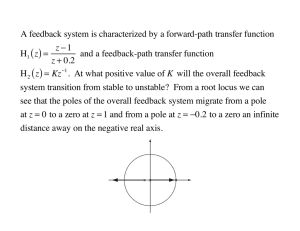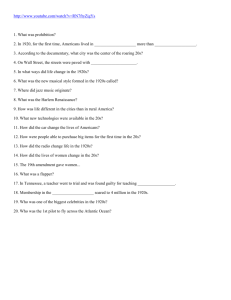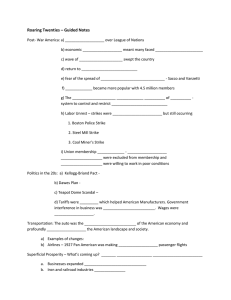Architecture and assembly of the archaeal Cdc48*20S proteasome Please share
advertisement
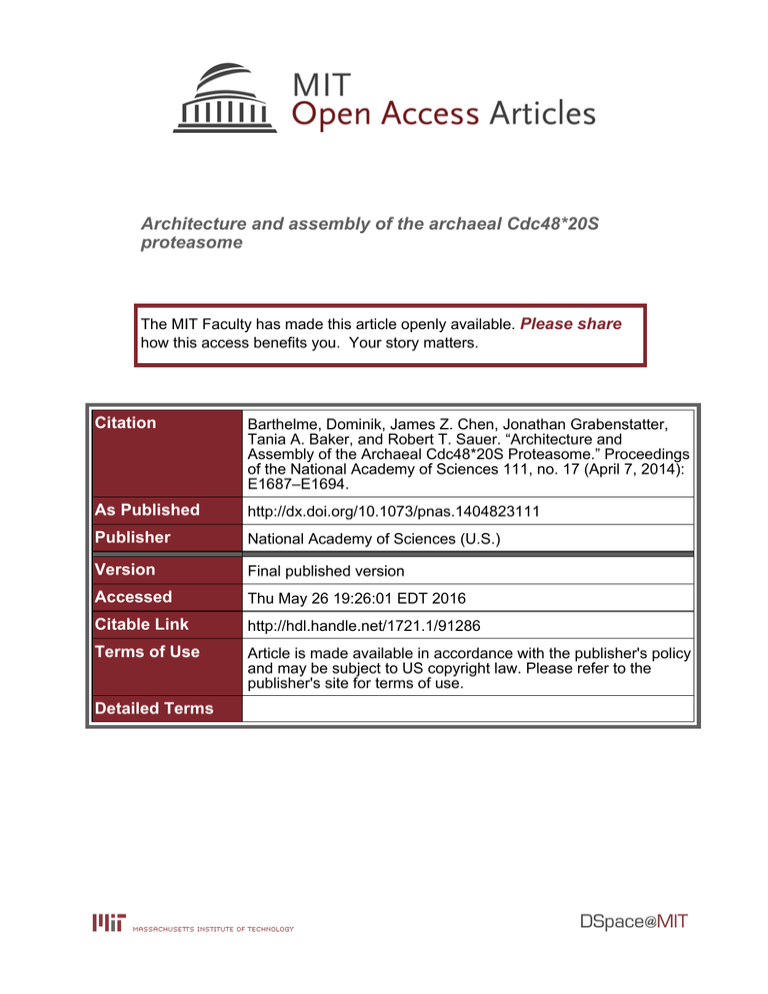
Architecture and assembly of the archaeal Cdc48*20S
proteasome
The MIT Faculty has made this article openly available. Please share
how this access benefits you. Your story matters.
Citation
Barthelme, Dominik, James Z. Chen, Jonathan Grabenstatter,
Tania A. Baker, and Robert T. Sauer. “Architecture and
Assembly of the Archaeal Cdc48*20S Proteasome.” Proceedings
of the National Academy of Sciences 111, no. 17 (April 7, 2014):
E1687–E1694.
As Published
http://dx.doi.org/10.1073/pnas.1404823111
Publisher
National Academy of Sciences (U.S.)
Version
Final published version
Accessed
Thu May 26 19:26:01 EDT 2016
Citable Link
http://hdl.handle.net/1721.1/91286
Terms of Use
Article is made available in accordance with the publisher's policy
and may be subject to US copyright law. Please refer to the
publisher's site for terms of use.
Detailed Terms
PNAS PLUS
Architecture and assembly of the archaeal
Cdc48·20S proteasome
Dominik Barthelmea,1, James Z. Chena,1,2, Jonathan Grabenstatterb, Tania A. Bakera,c, and Robert T. Sauera,3
Departments of aBiology and bEarth and Planetary Sciences and cHoward Hughes Medical Institute, Massachusetts Institute of Technology, Cambridge,
MA 02139
ATP-dependent proteases maintain protein quality control and
regulate diverse intracellular functions. Proteasomes are primarily
responsible for these tasks in the archaeal and eukaryotic domains
of life. Even the simplest of these proteases function as large
complexes, consisting of the 20S peptidase, a barrel-like structure
composed of four heptameric rings, and one or two AAA+ (ATPase
associated with a variety of cellular activities) ring hexamers,
which use cycles of ATP binding and hydrolysis to unfold and
translocate substrates into the 20S proteolytic chamber. Understanding how the AAA+ and 20S components of these enzymes
interact and collaborate to execute protein degradation is important, but the highly dynamic nature of prokaryotic proteasomes
has hampered structural characterization. Here, we use electron
microscopy to determine the architecture of an archaeal Cdc48·20S
proteasome, which we stabilized by site-specific cross-linking. This
complex displays coaxial alignment of Cdc48 and 20S and is enzymatically active, demonstrating that AAA+ unfoldase wobbling
with respect to 20S is not required for function. In the complex,
the N-terminal domain of Cdc48, which regulates ATP hydrolysis
and degradation, packs against the D1 ring of Cdc48 in a coplanar
fashion, constraining mechanisms by which the N-terminal domain
alters 20S affinity and degradation activity.
AAA+ protease
| dynamic wobbling model | p97/VCP
P
roteasomes are large macromolecular complexes that degrade misfolded or damaged proteins to maintain cellular
homeostasis and quality control in all domains of life. In addition,
selective proteasomal turnover of regulatory proteins is often a
critical element of signaling cascades that allow cells to respond
to changing conditions and environmental stress (1, 2). Proteasomes consist of the self-compartmentalized 20S peptidase and
one or two AAA+ (ATPase associated with a variety of cellular
activities) family ring hexamers. The α7β7β7α7 ring topology of the
20S enzyme ensures that the proteolytic active sites, which reside
in the β-subunits, are sequestered and can only cleave substrates
that enter the chamber through narrow axial pores formed by the
α-subunits (3). As a consequence, ATP-dependent unfolding of
natively folded protein substrates by the AAA+ ring and subsequent polypeptide translocation through a narrow axial channel
and into the 20S chamber are required for degradation (4).
Although the 20S peptidase is the degradation module in all
proteasomes, the associated AAA+ unfolding machines differ.
For example, homohexamers of Mpa/Arc in actinobacteria and
PAN in archaea serve as proteasomal motors, whereas a heterohexameric Rpt1–6 ring in the 19S particle is the motor of the
eukaryotic 26S proteasome (2, 5). Characteristic of type-I AAA+
enzymes, Mpa/Arc, PAN, and Rpt1–6 subunits contain a single
AAA+ module for ATP binding and hydrolysis (6). By contrast,
as found in type-II AAA+ enzymes, the homohexameric Cdc48
motor in the recently discovered archaeal Cdc48·20S proteasome
contains two AAA+ modules (7, 8). Cdc48 is essential in archaea
and eukaryotes, and structural studies of a mouse ortholog have
shown that its AAA+ modules are organized into discrete D1 and
D2 rings (9–11). Cdc48 also contains a family-specific N domain,
as well as a flexible C-terminal sequence, including an HbYX
www.pnas.org/cgi/doi/10.1073/pnas.1404823111
(hydrophobic, tyrosine, any residue) tripeptide important for 20S
binding, which is similar to motifs in Mpa/Arc, Pan, and Rpt1–6
(8). Electron microscopy (EM) has been used to probe the
structures of the PAN·20S archaeal proteasome and the 26S
eukaryotic proteasome (12, 13). These EM studies showed that
many unfoldase rings did not align coaxially with 20S, despite
making contact with the peptidase α-ring, resulting in wobbling distances as large as 30 Å. It was proposed that as ATP
hydrolysis progresses in the PAN and Rpt1–6 rings, wobbling
motions arise because the HbYX tails of newly ATP-bound subunits interact with binding pockets in the 20S α-subunit, whereas
HbYX motifs in posthydrolytic subunits assume a nonbinding
conformation (14). However, recent EM studies have shown that
the rings of Rpt1–6 and 20S shift into more symmetric and coaxially aligned positions upon substrate engagement, questioning
the functional importance of dynamic wobbling (15).
Eukaryotic Cdc48 (also known as p97 or VCP) plays crucial
roles in diverse cell functions, many involving the ubiquitin–
proteasome system and adaptor proteins that bind to the N
domain of Cdc48 (9). In some structures, the N domain packs
against the D1 ring; in other structures, it adopts positions above
or below the D1 ring or is disordered (16–18). Because these
movements correlate with bound nucleotide or the presence of
human-disease mutations, N-domain movements are thought to
be important for regulating Cdc48 function. In archaeal Cdc48,
deletion of the N domain increases 20S-binding affinity, increases rates of ATP hydrolysis, and increases unfolding/degradation
activity (8, 19). Breaking contacts between the N domain and the
Significance
From microbes to humans, proteolytic machines called proteasomes cleave proteins that are damaged or unnecessary into
peptide fragments. Proteasomes minimally consist of the barrellike 20S peptidase and an AAA+ ring, which harnesses chemical
energy to unfold and translocate proteins into the 20S chamber
for degradation. Here, we determine the architecture of a recently discovered proteasome, Cdc48·20S, by electron microscopy. A continuous axial channel allows translocation through
the double AAA+ rings of Cdc48 into the 20S chamber. A model
in which dynamic “wobbling” of the AAA+ unfoldase relative to
20S is necessary for function is ruled out for Cdc48·20S by electron-microscopy results showing coaxial alignment of Cdc48 and
20S and by the proteolytic activity of cross-linked complexes.
Author contributions: D.B., J.Z.C., and J.G. designed research; D.B., J.Z.C., and J.G. performed research; D.B. and J.Z.C. contributed new reagents/analytic tools; D.B., J.Z.C., J.G.,
and R.T.S. analyzed data; and D.B., J.Z.C., T.A.B., and R.T.S. wrote the paper.
The authors declare no conflict of interest.
Data deposition: The data reported in this paper have been deposited in the EMDataBank,
www.emdatabank.org (accession nos. EMD-5923 and EMD-5924).
1
D.B. and J.Z.C. contributed equally to this work.
2
Present address: Department of Biochemistry and Molecular Biology, Oregon Health and
Science University, Portland, OR 97239.
3
To whom correspondence should be addressed. E-mail: bobsauer@mit.edu.
This article contains supporting information online at www.pnas.org/lookup/suppl/doi:10.
1073/pnas.1404823111/-/DCSupplemental.
PNAS | Published online April 7, 2014 | E1687–E1694
BIOCHEMISTRY
Contributed by Robert T. Sauer, March 14, 2014 (sent for review January 20, 2014)
D1 ring might therefore be required for tight binding of Cdc48 to
the 20S peptidase and for enhanced activity.
Here, we determine EM structures of archaeal Cdc48–20S and
Cdc48ΔN–20S proteasomes, in which the C-terminal tails of Cdc48
were cross-linked to specific sites in the α ring of 20S. Importantly,
the cross-linked complexes are highly active in protein unfolding
and degradation. Although the resolution of both structures is low,
several features are clear. First, the Cdc48 and 20S rings are coaxially aligned. In combination with the activity of cross-linked
complexes, this result supports a model in which wobbling motions
are not required to allow protein degradation. Second, in the
Cdc48–20S structure, the N domain is packed in a coplanar
manner against the D1 ring. We discuss the implications of these
results in terms of current understanding of Cdc48 and proteasomal structure and function.
Results and Discussion
Nucleotide Effects on Complex Stability. We previously found that
Thermoplasma acidophilum Cdc48·20S and Cdc48ΔN·20S proteasomes assemble in an ATP-dependent manner with apparent
binding constants of ∼160 and ∼3 nM, respectively, but pull-down
B
50
peptide cleavage rate
(min-1 20S-1)
peptide cleavage rate
(min-1 20S-1)
A
40
ATP
30
~220x
20
ATPγS
10
0
0.001
experiments suggested that both complexes had relatively
short half-lives (8). Prior studies showed that complexes of
T. acidophilum 20S with PAN from another archaeal genus were
also kinetically unstable, and EM studies of this proteasome
were only possible by using adenosine 5′-gamma-thiotriphosphate (ATPγS), a nucleotide analog that was not hydrolyzed (13,
14). As a prelude to structural studies, we investigated whether
more stable Cdc48·20S complexes could be obtained using ATP
analogs. Surprisingly, however, Cdc48ΔN bound 20S far less tightly in
the presence of 2 mM ATPγS (Kapp ∼ 700 nM) than in the presence
of 2 mM ATP (Kapp ∼ 3 nM), as assayed by stimulation of
peptide cleavage (Fig. 1A). Indeed, we previously reported that
ATPγS did not support Cdc48 binding to 20S in a similar assay,
which was probably a consequence of very weak binding at
the enzyme concentrations used. We found that ADP·AlF4−,
a transition-state analog, also supported a functional interaction
between Cdc48ΔN and the 20S peptidase (Fig. 1B), but titration
experiments revealed that binding (Kapp ∼ 270 nM) was again
much weaker than observed with ATP (Fig. 1C). We also assayed
the 20S affinity of a Cdc48ΔN variant (E291Q/E568Q) that
cannot hydrolyze ATP rapidly because of mutations in the
50
20S
20S plus Cdc48∆N
40
30
20
10
0
0.01
0.1
1
∆N
[Cdc48 ] (μM)
10
ADP
D
C
ADP•AlF4-
Cdc48∆N plus 20S (ATP)
Cdc48∆N (ADP•AlF4-)
peptide cleavage rate
(min-1 20S-1)
50
Cdc48∆N•20S
40
30
20
20S
Cdc48∆N/E291Q/E568Q
(ATP)
10
0
0.001
0.01
0.1
1
10
[Cdc48∆N variant] (μM)
Fig. 1. Nucleotide dependence of assembly. (A) Stimulation of nonapeptide (10 μM) cleavage by the 20S peptidase (10 nM) as a function of increasing
Cdc48ΔN in the presence of 2 mM ATP or ATPγS. Values are averages ± SEM (n = 3). Lines are fits to a quadratic equation for near-stoichiometric binding (ATP)
or a one-site binding isotherm (ATPγS). Fitted Kapp values were 3 ± 1 nM (ATP) and 702 ± 9 nM (ATPγS). (B) Cdc48ΔN (1 μM) activates 20S (10 nM) cleavage of
the nonapeptide (10 μM) in the presence of 2 mM ADP·AlF4− but not ADP. Values are averages ± SEM (n = 3). (C) Stimulation of nonapeptide (10 μM) cleavage
by the 20S peptidase (10 nM) as a function of increasing Cdc48ΔN (in the presence of 2 mM ADP·AlF4−; Kapp = 270 ± 30 nM) or Cdc48ΔN/E291Q/E568Q (in the
presence of 2 mM ATP; Kapp = 240 ± 34 nM). Values are averages ± SEM (n = 3). Lines are fits to a one-site binding isotherm. (D) Representative examples of
negative-stained micrographs of Cdc48ΔN plus 20S in the presence of 2 mM ATP. Right shows an assembled Cdc48ΔN·20S complex (observed in ∼10–20% of
particles) and a particle of 20S alone.
E1688 | www.pnas.org/cgi/doi/10.1073/pnas.1404823111
Barthelme et al.
Cross-Linked Complexes. We initially generated cysteine-free variants of T. acidophilum Cdc48 (C77A/C679A; designated Cdc48*)
and 20S (αC151S; designated 20S*). Cdc48* was as active as
wild-type Cdc48 in ATP hydrolysis, protein unfolding, and protein
B
ATP hydrolysis
protein unfolding
protein degradation
100
75
50
25
xCdc48-20S
Cdc48*/L753C
20S
20
dimer
10
20S*
x20S*/K66C
dimer
100
h
h
300
400
500
io
ut
th
w
ATP hydrolysis
protein degradation
n
ro
ug
E
el
n
flo
io
200
time (s)
ug
ro
ut
th
Cdc48*/L753C
el
w
flo
xCdc48-20S
20S*/K66C
0
Cdc48*
D
Cdc48*/∆N/L753C
x20S*/K66C
0
Cdc48
xCdc48∆N-20S
BIOCHEMISTRY
peptide cleaved (μM)
% activity
125
0
C
30
100
xCdc48∆N-20S
Cdc48*/∆N/L753C
% activity
A
75
50
25
S
-2
∆N
48
dc
C
x
C
dc
48
x
C
∆N
dc
pl
48
us
-2
20
0S
S
20
us
pl
48
dc
C
0S
0
20S*/K66C
Fig. 2. Cross-linked Cdc48–20S complexes are functional. (A) Rates of ATP hydrolysis, Kaede–ssrA unfolding, and SFGFP–ssrA degradation were determined at
45 °C for the cysteine-free Cdc48* variant and were normalized to Cdc48 values. Values are averages ± SEM (n = 3). Hydrolysis of ATP (2 mM) by Cdc48 or
Cdc48* (0.3 μM) was measured in the presence of an ATP-regeneration system. Unfolding of Kaede–ssrA (10 μM) by Cdc48 or Cdc48* (1 μM) and degradation
of SFGFP–ssrA (10 μM) by Cdc48 or Cdc48* (1 μM) plus 20S (3 μM) was measured in the presence of 10 mM ATP and a regeneration system. Rates of ATP
hydrolysis were 22 ± 0.29 min−1·enzyme (enz)−1 (Cdc48) and 20 ± 0.69 min−1·enz−1 (Cdc48*). Rates of Kaede–ssrA unfolding were 0.011 ± 0.002 min−1·enz−1
(Cdc48) and 0.013 ± 0.002 min−1·enz−1 (Cdc48*). Rates of sfGFP–ssrA degradation were 0.014 ± 0.001 min−1·enz−1 (Cdc48·20S) and 0.016 ± 0.004 min−1·enz−1
(Cdc48*·20S). (B) Cleavage of the tetrapeptide Suc-LLVY-Amc (100 μM) by 20S or 20S* (0.2 μM) was assayed at 45 °C. (C) Reducing SDS/PAGE gel following
BMOE cross-linking of Cdc48*/L745C or Cdc48*/ΔN/L745C (2 μM) to 20S*/K66C (12 μM). The positions of non-cross-linked reactants and cross-linked xCdc48–20S,
x
Cdc48ΔN–20S, and a x20S*/K66C dimer are shown. (D) Reducing SDS/PAGE following removal of excess non-cross-linked 20S*/K66C by affinity purification using
Strep-Tactin resin. (E) Rates of ATP hydrolysis and SFGFP–ssrA degradation by cross-linked xCdc48–20S or xCdc48ΔN–20S (1 μM) relative to Cdc48 or Cdc48ΔN
(1 μM) plus 20S (3 μM). Reactions were performed as described in A. Rates of ATP hydrolysis were 22 ± 1 min−1·enz−1 (Cdc48·20S), 21 ± 1 min−1·enz−1 (xCdc48–
20S), 245 ± 7 min−1·enz−1 (Cdc48ΔN·20S), and 287 ± 7 min−1·enz−1 (xCdc48ΔN–20S). Rates of degradation were 0.013 ± 0.002 min−1·enz−1 (Cdc48·20S), 0.013 ±
0.002 min−1·enz−1 (xCdc48–20S), 0.97 ± 0.017 min−1·enz−1 (Cdc48ΔN·20S), and 0.71 ± 0.016 min−1·enz−1 (xCdc48ΔN–20S).
Barthelme et al.
PNAS PLUS
degradation (Fig. 2A), and 20S* was as active as wild-type 20S
in peptide cleavage (Fig. 2B). We then introduced a cysteine
(L745C) at the X position of the C-terminal HbYX tripeptide of
Cdc48*, because these residues are hypothesized to dock into a
binding cleft in the 20S α ring (8, 20). We introduced another
cysteine (K66C) into the hydrophobic cleft of the α-subunit of
20S*. Attempts to form disulfide bonds between Cdc48*/L745C and
20S*/K66C by using copper-1,10-phenanthroline or 5,5′-dithiobis2-nitrobenzoic acid (DTNB) were complicated by intramolecular
cross-linking between Cdc48 protomers. However, reacting
20S*/K66C with 1,2-bis(maleimide)ethane (BMOE) followed by the
addition of substoichiometric Cdc48*/L745C or Cdc48*/ΔN/L745C resulted in cross-linking yields of 50% or more (Fig. 2C). Because
there are six potential sites of cross-linking, almost every complex contained at least one cross-link. Excess 20S*/K66C that was
not cross-linked to Cdc48*/L745C or Cdc48*/ΔN/L745C was removed
Walker-B ATPase motifs of the D1 and D2 rings. This protein
also bound 20S binding relatively weakly in the presence of
ATP (Kapp ∼ 240 nM) (Fig. 1C). In combination, these results
show that ATP supports the highest affinity of Cdc48 ΔN for
20S and suggest that strong 20S affinity requires ATP binding
and hydrolysis by Cdc48.
In negative-stain EM images of mixtures of 20S, Cdc48ΔN or
Cdc48, and ATP, we observed 10–20% complexes with Cdc48ΔN
(Fig. 1D) but almost no complexes with Cdc48, making structure
determination infeasible. To overcome this problem, we developed
a site-specific cross-linking procedure as described below.
PNAS | Published online April 7, 2014 | E1689
capped by a single Cdc48 or Cdc48ΔN hexamer, whereas <1%
doubly capped complexes were observed. As described in Materials
and Methods, 3D reconstruction yielded electron-density maps
for xCdc48–20S and xCdc48ΔN–20S at resolutions of ∼40 Å (Fig.
3C). Crystal structures of T. acidophilum 20S [Protein Data Bank
(PDB) ID code 1PMA] and mouse Cdc48/p97 (PDB ID code
3CF1) could be rigid-body-fitted into the density maps reasonably well (Fig. 3D).
In ∼90% of xCdc48–20S and xCdc48ΔN–20S images, the double ring of the Cdc48 hexamer aligned coaxially with the α7β7β7α7
rings of 20S. There were, however, images in which the Cdc48
rings were tilted relative to the 20S rings (Fig. 3 E, Left), potentially resulting from incomplete cross-linking and partial dissociation. As noted above, this wobbling phenomenon was reported
as a prominent feature for PAN·20S and the 26S proteasome (12,
13). In the 2D classes, the shared portions of xCdc48–20S and
x
Cdc48ΔN–20S were highly similar (Fig. 3B). In the 3D structures
by using an affinity purification (Fig. 2D). Below, we refer to
these cross-linked complexes as xCdc48–20S or xCdc48ΔN–20S.
Importantly, purified xCdc48–20S and xCdc48ΔN–20S hydrolyzed ATP and degraded a stable native protein at rates similar
to the noncovalent complexes (Fig. 2E). xCdc48–20S supported
peptide cleavage at a higher rate than Cdc48 plus 20S (Fig. S1).
Thus, cross-linking does not prevent protein unfolding by Cdc48,
Cdc48-mediated translocation of substrates into 20S, or 20S
proteolysis.
Cdc48–20S EM Structure. In negative-stain EM images, xCdc48ΔN–
20S particles preferentially assumed side-view orientations (Fig.
3A). The 2D class averages for xCdc48ΔN–20S and xCdc48–20S
particles clearly showed the overall architecture and interaction
between the Cdc48 double ring and the α7β7β7α7 rings of 20S
(Fig. 3B). xCdc48–20S had a width of ∼16 nm and a height of
∼24 nm. As a consequence of the enzyme stoichiometries during
cross-linking, the vast majority of complexes consisted of 20S
C
A
xCdc48-20S
xCdc48∆N-20S
top view
F
N
xCdc48∆N-20S
N
N-D1
Cdc48
N
D2
N
N
α
N
β
20S
side view
β
α
N
D
N
N
D1 ring
B
G
N
xCdc48∆N-20S class averages
axial
channel
N
N
N-D1
Cdc48
xCdc48-20S class averages
Cdc48
20S
E
tilted caps
D2
α
Cdc48
flexible N domains
20S
β
20S
β
α
Fig. 3. Negative-stain EM structures of the xCdc48–20S and xCdc48ΔN–20S proteasomes. (A) Representative electron micrograph of cross-linked xCdc48ΔN–20S
particles showing assembled complexes as the dominant species. (B) Representative class averages for xCdc48ΔN–20S proteasomes (Upper) and xCdc48–20S
proteasomes (Lower). (C) Shown are 3D reconstructions of the xCdc48–20S (Left) and xCdc48ΔN–20S (Right) proteasomes. (D) The crystal structures of mouse
Cdc48/p97 (PDB ID code 3CF1) and T. acidophilum 20S (PDB ID code 1PMA) in cartoon representation fit well into the xCdc48–20S electron-density map, as
shown in top and side views. In the Cdc48 structure, the N domains are colored dark blue, and the D1 and D2 rings are colored cyan. In the 20S structure, the α
rings are colored green and the β rings are colored orange. (E, Left) Some class averages of xCdc48ΔN–20S particles (∼10% of total) did not show coaxial
alignment of Cdc48 and 20S. (Right) In a few xCdc48–20S particles, the N domain had moved from its coplanar position to a position above the D1 AAA+ ring
or was generally flexible. (F) A 3D difference map of xCdc48–20S and xCdc48ΔN–20S localized the N domain (blue) to a position coplanar to the D1 ring. (G)
Cutaway of the electron-density map of xCdc48–20S showing a continuous axial channel through the rings of Cdc48 and 20S.
E1690 | www.pnas.org/cgi/doi/10.1073/pnas.1404823111
Barthelme et al.
Barthelme et al.
PNAS PLUS
ne
AD
P
AT
P
AT
Pγ
no S
ne
AD
P
AT
P
AT
Pγ
S
no
Cdc48*/P138C/N373C
oxidizing
conditions
reducing
conditions
B
ATP-hydrolysis rate
(min-1 hexamer-1)
20
re
du
ce
d
15
ox
id
ize
d
10
5
0
Cdc48*
Cdc48*/P138C/N373C
Cdc48*
peptide cleavage rate
(min-1 20S-1)
40
30
reduced
Cdc48*/P138C/N373C
20
oxidized
Cdc48*/P138C/N373C
10
0
0
6
3
TNB release (μM min-1)
D
2
4
[Cdc48* variant] (μM)
2
1
tro
n)
bu
ffe
rc
on
si
yp
(tr
3C
75
*/L
48
dc
C
C
dc
48
*/L
*/L
75
75
3C
3C
(A
(A
D
TP
)
P)
l
0
Fig. 4. Role of contacts between the N domain and D1 ring in ATP hydrolysis
and 20S binding and experiments probing accessibility of the HbYX tails. (A)
Nonreducing SDS/PAGE of Cdc48*/P138C/N373C following incubation with copper1,10-phenanthroline (10 μM) in the presence of different nucleotides (2 mM) or
no nucleotide (oxidizing conditions) or following oxidation and subsequent
incubation with 10 mM DTT (reducing conditions). (B) Rates of ATP hydrolysis
by reduced and oxidized Cdc48*/P138C/N373C. Values are averages ± SEM (n = 3).
Experiments were performed at 45 °C using 5 mM ATP, a regeneration system,
and 5 μM Cdc48 variant. (C) Stimulation of nonapeptide (10 μM) cleavage by
20S (10 nM) as a function of increasing concentrations of Cdc48* or oxidized or
reduced Cdc48*/P138C/N373C. Values are averages ± SEM (n = 3) and were fit to
a one-site binding isotherm. Kapp values were 358 ± 41 nM (Cdc48*), 379 ± 57
nM (reduced Cdc48*/P138C/N373C), and >2 μM (oxidized Cdc48*/P138C/N373C). (D)
Accessibility of the HbYX tail was probed by modification of the C-terminal
Cys745 in Cdc48*/L745C with DTNB in the presence of ADP or ATP (2 mM) or
following digestion of Cdc48*/L745C with trypsin.
PNAS | Published online April 7, 2014 | E1691
BIOCHEMISTRY
C
48
archaeal Cdc48, EM studies suggested that the N domain might
be flexible or extend away from the D1 ring, and deletion of the
N domain enhances ATP hydrolysis, protein unfolding, and
protein degradation, and strengthens 20S affinity (8, 19, 21, 22).
For eukaryotic Cdc48/p97, the N domain moves above or below
the D1 ring, depending upon the nucleotide state and the presence of human-disease mutations, and locking the N domain to
the D1 via a disulfide bond abrogates ATP hydrolysis (16–18,
23). These results are consistent with a model in which packing
of the N domain against the D1 ring negatively regulates multiple Cdc48 activities, and we anticipated that the N domain
might be disordered in the complex of archaeal Cdc48 with 20S.
In almost all Cdc48–20S complexes, however, the N domain
packed against the D1 ring in a coplanar fashion (Fig. 3 A and
C). Thus, packing of the N domain against the D1 ring is compatible with 20S binding, even it these contacts alter Cdc48/p97
activity and 20S binding affinity.
To determine the effects of disulfide locking the archaeal N
domain to the D1 ring, we constructed Cdc48P138C/N373C based
on homology and the previous p97 experiments (23). After oxidation with copper-1,10-phenanthroline, disulfide-bond formation was 50–80% complete, depending on the nucleotide (Fig.
4A). Compared with Cdc48*, reduced Cdc48*/P138C/N373C was
approximately twofold less active in ATP hydrolysis, and oxidized Cdc48*/P138C/N373C was approximately sixfold less active
(Fig. 4B). Reduced Cdc48*/P138C/N373C bound 20S with essentially
the same affinity as Cdc48*, whereas oxidized Cdc48*/P138C/N373C
bound 20S substantially more weakly (Fig. 4C). We conclude
that the exact nature of interactions between the N domain and
the D1 ring affect ATP hydrolysis but do not preclude 20S
binding, consistent with our EM structures. What then accounts
for the ∼100-fold increase in 20S affinity and enhanced activity
when the N domain of archaeal Cdc48 is deleted? We assume
that there must be modest conformational changes in Cdc48ΔN
and its interface with the 20S α ring that are not evident at the
low resolution of our EM structures.
disulfide bonded
reduced
dc
Regulation of Cdc48 Activity and 20S Binding by the N Domain. For
nucleotide
A
C
(Fig. 3C), the D2 ring also assumed a fixed position with respect
to 20S, suggesting that there is relatively little flexibility in the
complex. On the outer edge and coplanar with the D1 ring, welldefined density was observed in xCdc48–20S, but not xCdc48ΔN–
20S, both in 2D classes and the 3D reconstruction, which we
assigned as the N domain (Fig. 3 D and F). In <5% of all xCdc48–
20S classes, the N domain was observed at a position above the
D1 ring, or density was missing (Fig. 3 E, Right), suggesting disorder.
In the 3D reconstructions of xCdc48ΔN–20S and xCdc48–20S, the
α7β7β7α7 rings of 20S were unequivocally identified, and the α7
ring proximal to Cdc48 had a larger diameter than the distal α7
ring (Fig. 3 C and D). This difference presumably reflects changes
needed to accommodate docking, but could also be a consequence
of allosteric communication between Cdc48 and 20S. At the resolution of the structure, a continuous axial channel passed through
the D1 and D2 rings of Cdc48 and the α and β rings of 20S
(Fig. 3G).
In the 3D reconstruction of xCdc48ΔN–20S, weak electron
density was observed on top and near the axis of the D1 ring (Fig.
3 C and F and Fig. S2), but the source of this additional density
is uncertain. Possibilities include density from a conformational
change in some D1 AAA+ rings; density from the N-terminal
affinity tag, which is located near this position; and/or density from
a heterogeneous population of Cdc48ΔN polypeptide in the process of being degraded, because ATP-dependent autodegradation
of the Cdc48ΔN subunit by Cdc48ΔN·20S was observed (Fig. S3).
This extra density was not observed in the xCdc48–20S structure
(Fig. 3C and Fig. S2), and no significant autodegradation was
detected for Cdc48·20S (Fig. S3).
Wobbling Does Not Appear to Be Functionally Important. Based on
PAN·20S and early 26S proteasome EM studies, the AAA+
unfolding ring was proposed to wobble relative to the 20S peptidase, with an ordered sequence of ATP binding and hydrolysis
resulting in conformational changes in the C-terminal tails that
result in sequential making and breaking of contacts between the
HbYX motifs and the 20S α ring (12–14). This model has been
challenged by recent high-resolution cryo-EM structures of substratebound 26S proteasome, which show almost perfect coaxial alignment of the AAA+ Rpt1–6 ring and the 20S α7β7β7α7 rings (15, 24).
Our results show coaxial alignment of the Cdc48 AAA+ rings with
the 20S rings and establish that cross-linked complexes are active
proteases. Collectively, these results imply that wobbling is not
a general requirement for those proteasomal complexes and suggest
that it may largely be an artifact of the kinetic instability of 20S
complexes with AAA+ unfolding rings.
We found that a cysteine introduced at the C terminus of the
HbYX motif in Cdc48*/L745C reacted with DTNB at similar rates
in the presence of ATP or ADP and after cleavage of this protein
with trypsin (Fig. 4D). These results suggest that nucleotide
binding to Cdc48 does not change the accessibility of the HbYX
motif substantially and thus is unlikely to control 20S binding by
this mechanism. Previous studies have shown that the pore two
loops of the Cdc48 D2 ring also contribute to 20S binding (7), and
nucleotide-dependent changes in the D2 ring and these loops,
which directly follow the Walker-B motif for ATP hydrolysis, may
account for the ATP requirement for high-affinity 20S binding.
Potential Roles of ATP Hydrolysis in Cdc48 Binding to 20S. We found
that ATPγS and ADP·AlF4− support Cdc48ΔN binding to the 20S
peptidase, but with much weaker affinities than observed with ATP,
suggesting that ATP hydrolysis is important for Cdc48 to form
a high-affinity complex with 20S. Consistently, in the presence of
ATP, the ATPase-defective Cdc48ΔN/E291Q/E568Q variant binds the
20S peptidase ∼100-fold more weakly than Cdc48ΔN. Although the
mechanism by which ATP hydrolysis strengthens binding remains
to be elucidated, we suggest two simple possibilities. In the first
model, the D2 ring might assume a conformation following partial
or complete ATP hydrolysis that could make additional or better
contacts with 20S, but the lifetime of this high-affinity conformation
is transient, and it decays rapidly unless there is ongoing ATP hydrolysis in both the D1 and D2 rings. In the second model, Cdc48
rings with a mixture of bound ATP and ADP might assume conformations with the highest 20S affinity. Indeed, such behavior was
reported for the PAN·20S proteasome, although ATP is inferior to
ATPγS in supporting high-affinity binding of PAN to 20S (14).
Mechanism of Protein Remodeling. An early crystal structure showed
that the axial pore of Cdc48 was blocked by a metal ion, and many
models of mechanical function were therefore proposed that do
not involve polypeptide translocation (11). However, our findings
that archaeal Cdc48 and variants of mammalian Cdc48/p97
function with the 20S peptidase in protein degradation strongly
support a translocation model (7, 8). Our structures, which show
a continuous axial channel through the D1, D2, and 20S α- and
β-rings (Fig. 3G), provide additional support for this model. In this
regard, we note that there is also strong evidence that the doublering ClpB and Hsp-104 disaggregation chaperones operate by
using translocation mechanisms (25, 26). Although these results do
not rule out alternative models, we believe that many mechanical
remodeling functions of Cdc48/p97 can be explained by a polypeptide-translocation mechanism.
Materials and Methods
Cloning, Expression, and Protein Purification. T. acidophilum Cdc48 mutants
were generated by site-directed mutagenesis with Phusion DNA polymerase
(New England Biolabs) using N-terminal His6TEV-tagged Cdc48 in pET22b as
a template (8). The endogenous C77 and C679 residues were mutated to
E1692 | www.pnas.org/cgi/doi/10.1073/pnas.1404823111
alanine to create cysteine-free Cdc48*. For cross-linking to 20S, we constructed a Cdc48*/L745C variant in which the His6TEV tag was replaced with
the MWSHPQFEKGGS sequence (StrepII tag and GGS linker). To create
cysteine-free 20S*, the endogenous C151 residue in the T. acidophilum 20S
α-subunit was replaced by serine and a C-terminal His6 tag was added to the
β-subunit. For N-domain disulfide locking experiments, we introduced the
P138C and N373C mutations into Cdc48*.
Cdc48 and 20S variants were expressed in E. coli BL21-RIL cells as described
(8). Proteins were initially purified by affinity chromatography on Strep-Tactin
Superflow resin (Qiagen) or Ni2+-NTA resin (Thermo Scientific), in the presence
of 1 mM DTT and 1 mM EDTA. Proteins were then dialyzed against 20 mM
Tris·HCl, 50 mM NaCl, 5 mM EDTA, and 1 mM DTT, loaded onto a MonoQ
anion-exchange chromatography column (GE Healthcare), and eluted by
applying a linear salt gradient to 600 mM NaCl. Proteins were concentrated
by Amicon centrifugation devices (100-kDa cutoff; Millipore) and further
purified by size-exclusion chromatography on a Superdex S-200 column
(GE Healthcare) in 20 mM Hepes–KOH (pH 7.5), 50 mM NaCl, 1 mM DTT, and
1 mM EDTA. SFGFP-ssrA and Kaede-ssrA were expressed and purified as described (27, 28). All proteins were frozen in liquid nitrogen and stored
at −80 °C. Protein concentrations were determined by UV-visible absorption
and are reported as Cdc48 hexamer equivalents or 20S α7β7β7α7 equivalents.
Protein Cross-Linking. Residues suitable for cross-linking Cdc48 to 20S were
identified by analyzing PA26-bound 20S structures (PDB ID codes 3JRM, 1YA7,
and 3IPM) using the program Disulfide by Design (20, 29–31). For EM
structural analyses, we cross-linked Cdc48*/ΔN/L745C to 20S*/K66C and crosslinked Cdc48*/L745C to 20S* bearing αK33C and βT1A mutations. Before crosslinking, the 20S and Cdc48 proteins were buffer-exchanged twice into
desalting buffer (20 mM Tris·HCl, pH 8.0, 100 mM NaCl, 1 mM EDTA) by using
Micro-Spin columns (Bio-Rad) to remove DTT from the storage buffer. The
20S* variants were activated by incubation with 5 mM BMOE (Thermo Scientific) for 30 min at room temperature after lowering the pH to 6.5.
Unreacted BMOE was removed from 20S by buffer exchange, and xCdc48–
20S complexes were formed by mixing 2 μM Cdc48 variants with 12 μM activated 20S by incubation in cross-linking buffer (100 mM Hepes–KOH, pH
6.5, 100 mM NaCl, 20 mM MgCl2 5 mM EDTA, and 5 mM ATP) at 37 °C for 2 h.
Reactions were stopped by adding 10 mM iodoacetic acid, and cross-linking
was analyzed by SDS/PAGE followed by staining with Coomassie blue.
x
Cdc48–20S complexes were further purified on Strep-Tactin resin (Qiagen)
to remove non-cross-linked 20S.
To lock the N domain and D1 ring with a disulfide, the Cdc48*/P138C/N373C
mutant was buffer-exchanged into 20 mM Tris·HCl (pH 8.0) and 100 mM
NaCl by using a Micro-Spin column and then incubated with 10 μM copper-1,10phenantroline for 3 h at 37 °C, before 5 mM EDTA was added to stop the reaction. Disulfide-bond formation was analyzed by changes in electrophoretic
mobility following nonreducing SDS/PAGE.
Assays. Cleavage of Mca-AKVYPYPME-Dpa(Dnp)-amide by 20S in the presence or the absence of Cdc48 was assayed at 45 °C as described, except that
DDT was omitted from the reaction (8). For peptidase assays in the presence
of ADP·AlF4−, 2 mM Al(NO3)3, and 12 mM NaF were added to reaction buffer
that contained 2 mM ADP and were preincubated for 20 min before starting
the reaction by adding peptide. ATP hydrolysis was measured by a NADHcoupled colorimetric assays in the presence of an ATP-regeneration system
(10 U·mL−1 pyruvate kinase, 10 U·mL−1 lactate dehydrogenase, 1 mM NADH,
and 7.5 mM phosphoenolpyruvate) and 5 mM ATP. Reactions were performed in 30 μL of PD buffer (20 mM Hepes–KOH, pH 7.5, 100 mM KCl, 20
mM MgCl2) with 0.3 μM Cdc48 variants at 45 °C. Reaction components were
preincubated at 45 °C for 20 min before starting reactions by adding ATP.
Protein unfolding was measured by changes in photo-cleaved Kaede-ssrA
fluorescence (excitation, 540 nm; emission, 580 nm) at 45 °C in 50 mM
Hepes–KOH, 100 mM KCl, 20 mM MgCl2, 5 mM ATP, and an ATP-regenerating system (20 U·mL−1 pyruvate kinase; 15 mM phosphoenolpyruvate).
Reaction components were preincubated for 20 min before starting the
unfolding reactions by adding ATP. Protein degradation was measured by
the loss of SFGFP-ssrA fluorescence (excitation, 467 nm; emission, 511 nm) in
the presence of 0.9 μM 20S peptidase with 0.3 μM Cdc48 variants or with
0.3 μM x Cdc48–20S or xCdc48 ΔN –20S complexes as described above.
The accessibility of the C-terminal cysteine residue in the HbYX motif of
Cdc48*/L745C was probed by measuring the reaction kinetics of modification
with DTNB by increases in absorption at 412 nm. Cdc48*/L745C (10 μM) was
incubated at 45 °C in PD buffer with 5 mM ATP or ADP, and reactions were
started by adding 0.1 mM DTNB. Rates were also determined for trypsindigested Cdc48*/L745C to ensure full accessibility of the HbYX tails and for
DTNB hydrolysis in reaction buffer alone.
Barthelme et al.
A Direct Method for 2D Classification in Single-Particle EM. In ab initio singleparticle 3D reconstruction, an initial model is first derived either by commonline-based angular reconstitution or by the random-conical-tilt technique. In
both ab initio methods, particle 2D classification assumes a pivotal role in
identifying distinct projection views and enhancing the image SNR via in-class
averaging. In the conventional approach of 2D classification, particle images
are first aligned to establish pixel registration across all frames, which are
then subjected to principal component analysis (PCA) and clustering in a
reduced eigenspace. To align the particles, the target functions frequently rely
on the cross-correlation (CC) between the particle image and a set of references.
However, because CC often produces spurious peaks under the noise typical
in EM images, erroneous alignments often lead to false classification and
ultimately low-resolution or even incorrect model reconstruction. To overcome the uncertainty induced by low SNR in particle alignment and classifi-
1. For each particle p in the data stack, systematically translate and rotate
the image at discrete steps of pixel precision that enumerate the complete
2D-alignment parameter space (Fig. S5A). For instance, given a particle of
30 pixels in diameter approximately centered in a 64 × 64-pixel image, at
3° rotational steps and ±10 pixels translations in X/Y of the frame, each
image will generate 120 × 21 × 21 = 52,920 distinct transformations. As
a result, the original stack {p} is expanded by 52,920 times to {px}, and the
data expansion eliminates the need for particle alignment. From here
on, p will be referred to as “the original particle” before syntheticimage transformation.
2. Apply pixel-based PCA directly on the expanded {px} and construct a reduced eigenspace. Then, decompose all images of {px} in the eigenspace
and identify a tight cluster centered around each original particle p. This
cluster will be referred to as “the class seeded by p” and is denoted as C
(p). At this stage, there are as many seeded classes as the number of
original particles in {p}, and each class contains at least one member,
the seed itself.
3. Class pruning via “mutual inclusion” (Fig. S5B): For two original particles
p, q and their transformed images pt, qT (where t and T are inversely
related), if pt ∈ C(q) but qT ∉ C(p), then pt is removed from C(q). After
pruning, the mutual inclusion of class seeds is guaranteed: If pt ∈ C(q),
then qT ∈ C(p). The mutual inclusion between p and q requires close
proximity of both (pt, q) and (qT, p) in the reduced eigenspace, and therefore enforces the stability and reliability of the resulting classes.
In the application to the classification of Cdc48–20S particles—which are
∼24 nm in the longest dimension and boxed into 64 × 64 frames at 7.05 Å
per pixel—3° rotations and ± 10-pixel maximal translations were used in the
systematic data expansion to ensure pixel precision. Ultimately, 2,820 classes
(with 32 particles per class on average) were identified for the xCdc48–20S
dataset, and 4,880 classes (with 39 particles per class on average) were
identified for the xCdc48ΔN–20S dataset.
Unlike conventional classification methods that partition a particle stack
into a much smaller number of groups, DPC creates one class for each original
particle, from which the stability of the class can be assessed via the
agreement between classes and among the class members. Unstable classes,
which are often seeded by false particles or contaminants with low membership, are then rejected. As a result, the total number of classes is determined through algorithmic pruning instead of by often ambiguous and
subjective user request.
The DPC function has been implemented in the PARTICLE package that is
available for public access on SBGrid (www.sbgrid.org/software/title/PARTICLE).
The performance of DPC has been validated on public benchmarks provided
by the National Resource for Automated Molecular Microscopy at The Scripps
Research Institute.
ACKNOWLEDGMENTS. We thank the Koch Institute for Integrative Cancer
Research (Massachusetts Institute of Technology) for access and help with their
EM facility; Ruben Jauregui for help with protein expression and purification;
and Gabe Lander and Andy Martin for critical reading of the paper and advice.
This work was supported by National Institutes of Health Grants AI-16892 and
GM-49224. D.B. was supported by Deutsche Forschungsgemeinschaft Grant BA
4890/1-1. T.A.B. is an employee of the Howard Hughes Medical Institute.
1. Finley D (2009) Recognition and processing of ubiquitin-protein conjugates by the
proteasome. Annu Rev Biochem 78:477–513.
2. Voges D, Zwickl P, Baumeister W (1999) The 26S proteasome: A molecular machine
6. Sauer RT, Baker TA (2011) AAA+ proteases: ATP-fueled machines of protein destruction.
Annu Rev Biochem 80:587–612.
7. Barthelme D, Sauer RT (2013) Bipartite determinants mediate an evolutionarily con-
designed for controlled proteolysis. Annu Rev Biochem 68:1015–1068.
3. Groll M, et al. (2000) A gated channel into the proteasome core particle. Nat Struct
Biol 7(11):1062–1067.
4. Kish-Trier E, Hill CP (2013) Structural biology of the proteasome. Annu Rev Biophys 42:29–49.
5. Maupin-Furlow J (2012) Proteasomes and protein conjugation across domains of life.
Nat Rev Microbiol 10(2):100–111.
served interaction between Cdc48 and the 20S peptidase. Proc Natl Acad Sci USA
110(9):3327–3332.
8. Barthelme D, Sauer RT (2012) Identification of the Cdc48·20S proteasome as an ancient AAA+ proteolytic machine. Science 337(6096):843–846.
9. Baek GH, et al. (2013) Cdc48: A Swiss army knife of cell biology. J Amino Acids 2013:
183421.
Barthelme et al.
PNAS PLUS
cation, one of us (J.Z.C.) developed a “direct particle classification” (DPC)
technique that eliminates image registration in the process.
The objective of particle 2D classification is to produce SNR-enhanced
projection views, from which 3D reconstruction can proceed. In the conventional practice, particles are partitioned into a small number of classes,
and the class averages represent the most popular projections. This goal can
also be achieved by an orthogonal approach on an individual basis by formulating the task as: “For each particle image, what others in the dataset
agree with it?” In contrast to the class-centric “group consensus,” the particle-centric approach focuses on analyzing the conformational variation
around each image instance. The algorithm proceeds as follows:
PNAS | Published online April 7, 2014 | E1693
BIOCHEMISTRY
Single-Particle EM Data Collection and Analysis. xCdc48–20S or xCdc48ΔN–20S
complexes (30 nM) were incubated in 5 mM ATP for 10 min at 45 °C, before
being negatively stained with uranyl acetate [1% (wt/vol)] on continuous
carbon-film grids. Electron micrographs of single particles were recorded by
using a 2K × 2K CCD camera on a JEOL JEM-2100F electron microscope at 200
KeV, 30,000× nominal magnification. For xCdc48–20S, 4,724 particles were
collected in 183 CCD images. For xCdc48ΔN–20S, 5,260 particles were collected in 101 images. In both datasets, the imaging defocus range was between 1.5 and 2.5 μm. Particle images were boxed and 2×-binned to 7.05 Å
per pixel. Because of their elongated shape, almost all of the particles assumed side views in images. Each dataset was subjected to direct classification, a reference-free and alignment-free classification function (described
in more detail below) in the PARTICLE software package (www.sbgrid.org/
software/title/PARTICLE). A total of 2,820 classes were identified for xCdc48–
20S, and 4,880 classes were identified for xCdc48ΔN–20S.
Because all particle images were side views, their common lines were
mostly coaxially aligned and poorly suited for ab initio angular reconstitution.
We therefore resorted to tomographic imaging and single-particle tomogram averaging to create an initial 3D model for the xCdc48ΔN–20S complex.
The tomographic data were collected on an FEI T12 electron microscope, and
the tilt-series coverage was from −30° to +30° at intervals of 2°. The relatively small tilting range was used to avoid imaging artifacts from staining at
high-tilt angles, while the adverse missing-wedge effect was mitigated by
the intrinsic symmetry of the assembly. A total of 28 single-particle tomograms were collected, from which 4 particles with the Cdc48–20S axial direction closely aligned to the tilt axis were selected for tomogram averaging
after applying C6- and C7-symmetrization in the Cdc48 and 20S regions,
respectively. The resulting density map served as the initial reference for the
single-particle 3D reconstruction and refinement for both the xCdc48ΔN–20S
and xCdc48–20S datasets.
In each case, class-averaged particle images [with enhanced signal-tonoise ratio (SNR)] were manually pruned to remove the Cdc48–20S assemblies that were not coaxially aligned, or the N domain was disordered in the
case of full-length construct (<10% of the total classes). The remaining class
averages—2,612 for xCdc48–20S and 4,575 for xCdc48ΔN–20S—were first
aligned to the initial reference by an exhaustive projection-matching search
(C1; no symmetry assumption) within 30° from the axial direction. The
density map derived from the aligned class averages then served as the new
reference for the subsequent iterative refinement. Once the process converged, the alignment parameters of the class-average images were
assigned to the respective seed image (defined in the direct particle classification algorithm; A Direct Method for 2D Classification in Single-Particle
EM) of the class for the final round of refinement and 3D reconstruction.
The resolution was measured at ∼39 Å for the xCdc48ΔN–20S density map
and ∼42 Å for the xCdc48–20S density map. The resolution measurement
and the Euler-angle distribution of both reconstructions are plotted in Fig. S4.
The electron-density maps for xCdc48–20S and xCdc48ΔN–20S have been
deposited to the EMDataBank (accession codes EMD-5923 and EMD-5924,
respectively).
10. Allers T, Barak S, Liddell S, Wardell K, Mevarech M (2010) Improved strains and
plasmid vectors for conditional overexpression of His-tagged proteins in Haloferax
volcanii. Appl Environ Microbiol 76(6):1759–1769.
11. DeLaBarre B, Brunger AT (2003) Complete structure of p97/valosin-containing protein
reveals communication between nucleotide domains. Nat Struct Biol 10(10):856–863.
12. Walz J, et al. (1998) 26S proteasome structure revealed by three-dimensional electron
microscopy. J Struct Biol 121(1):19–29.
13. Smith DM, et al. (2005) ATP binding to PAN or the 26S ATPases causes association with
the 20S proteasome, gate opening, and translocation of unfolded proteins. Mol Cell
20(5):687–698.
14. Smith DM, Fraga H, Reis C, Kafri G, Goldberg AL (2011) ATP binds to proteasomal
ATPases in pairs with distinct functional effects, implying an ordered reaction cycle.
Cell 144(4):526–538.
15. Matyskiela ME, Lander GC, Martin A (2013) Conformational switching of the 26S
proteasome enables substrate degradation. Nat Struct Mol Biol 20(7):781–788.
16. Rouiller I, et al. (2002) Conformational changes of the multifunction p97 AAA ATPase
during its ATPase cycle. Nat Struct Biol 9(12):950–957.
17. Tang WK, et al. (2010) A novel ATP-dependent conformation in p97 N-D1 fragment
revealed by crystal structures of disease-related mutants. EMBO J 29(13):2217–2229.
18. DeLaBarre B, Brunger AT (2005) Nucleotide dependent motion and mechanism of
action of p97/VCP. J Mol Biol 347(2):437–452.
19. Gerega A, et al. (2005) VAT, the thermoplasma homolog of mammalian p97/VCP, is an
N domain-regulated protein unfoldase. J Biol Chem 280(52):42856–42862.
20. Förster A, Masters EI, Whitby FG, Robinson H, Hill CP (2005) The 1.9 A structure of
a proteasome-11S activator complex and implications for proteasome-PAN/PA700
interactions. Mol Cell 18(5):589–599.
E1694 | www.pnas.org/cgi/doi/10.1073/pnas.1404823111
21. Rockel B, et al. (1999) Structure of VAT, a CDC48/p97 ATPase homologue from the
archaeon Thermoplasma acidophilum as studied by electron tomography. FEBS Lett
451(1):27–32.
22. Rockel B, Jakana J, Chiu W, Baumeister W (2002) Electron cryo-microscopy of VAT, the
archaeal p97/CDC48 homologue from Thermoplasma acidophilum. J Mol Biol 317(5):
673–681.
23. Niwa H, et al. (2012) The role of the N-domain in the ATPase activity of the mammalian AAA ATPase p97/VCP. J Biol Chem 287(11):8561–8570.
24. Beckwith R, Estrin E, Worden EJ, Martin A (2013) Reconstitution of the 26S proteasome reveals functional asymmetries in its AAA+ unfoldase. Nat Struct Mol Biol
20(10):1164–1172.
25. Wendler P, et al. (2009) Motor mechanism for protein threading through Hsp104. Mol
Cell 34(1):81–92.
26. Haslberger T, et al. (2008) Protein disaggregation by the AAA+ chaperone ClpB involves partial threading of looped polypeptide segments. Nat Struct Mol Biol 15(6):
641–650.
27. Glynn SE, Nager AR, Baker TA, Sauer RT (2012) Dynamic and static components power
unfolding in topologically closed rings of a AAA+ proteolytic machine. Nat Struct Mol
Biol 19(6):616–622.
28. Nager AR, Baker TA, Sauer RT (2011) Stepwise unfolding of a β barrel protein by the
AAA+ ClpXP protease. J Mol Biol 413(1):4–16.
29. Yu Y, et al. (2010) Interactions of PAN’s C-termini with archaeal 20S proteasome and
implications for the eukaryotic proteasome-ATPase interactions. EMBO J 29(3):692–702.
30. Dombkowski AA (2003) Disulfide by Design: A computational method for the rational
design of disulfide bonds in proteins. Bioinformatics 19(14):1852–1853.
31. Stadtmueller BM, et al. (2010) Structural models for interactions between the 20S
proteasome and its PAN/19S activators. J Biol Chem 285(1):13–17.
Barthelme et al.
